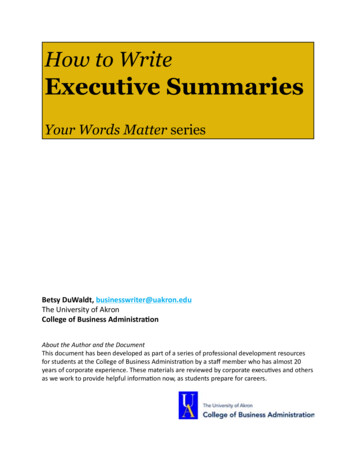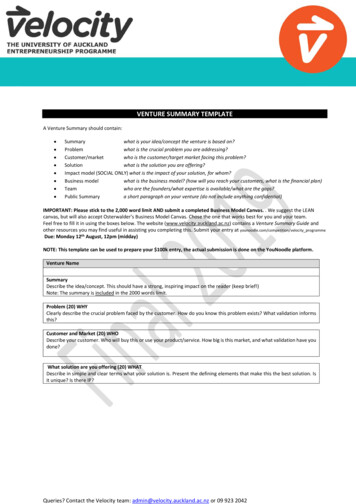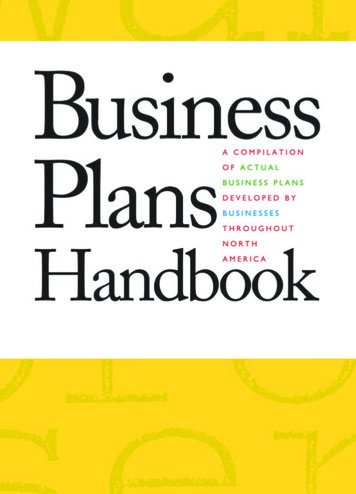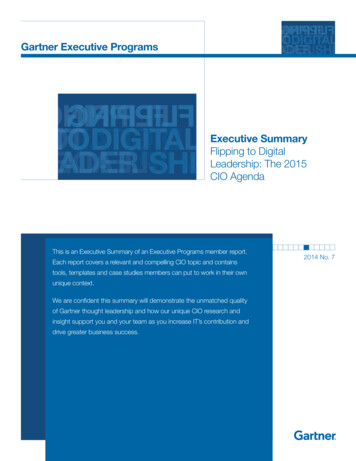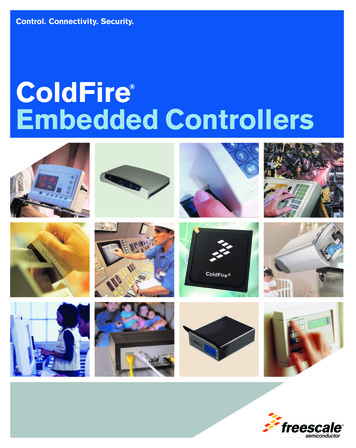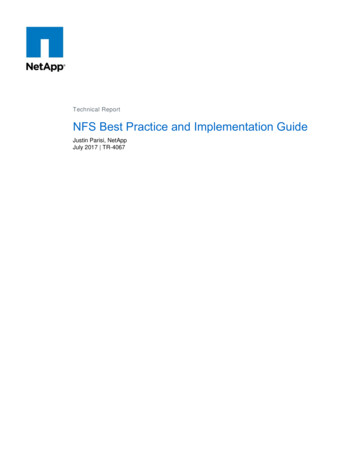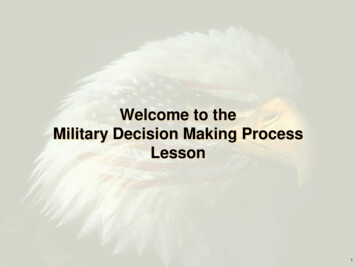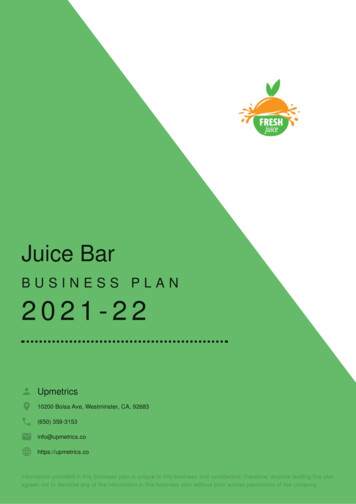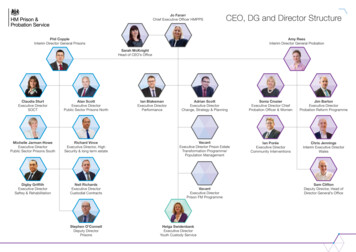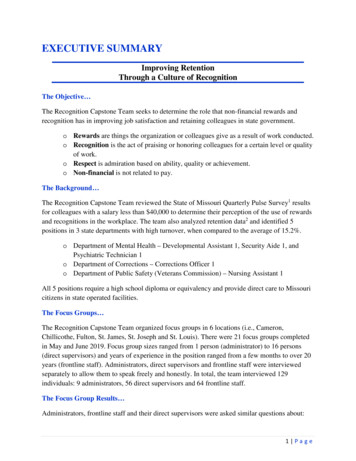
Transcription
EXECUTIVE SUMMARYImproving RetentionThrough a Culture of RecognitionThe Objective The Recognition Capstone Team seeks to determine the role that non-financial rewards andrecognition has in improving job satisfaction and retaining colleagues in state government.o Rewards are things the organization or colleagues give as a result of work conducted.o Recognition is the act of praising or honoring colleagues for a certain level or qualityof work.o Respect is admiration based on ability, quality or achievement.o Non-financial is not related to pay.The Background The Recognition Capstone Team reviewed the State of Missouri Quarterly Pulse Survey1 resultsfor colleagues with a salary less than 40,000 to determine their perception of the use of rewardsand recognitions in the workplace. The team also analyzed retention data2 and identified 5positions in 3 state departments with high turnover, when compared to the average of 15.2%.o Department of Mental Health – Developmental Assistant 1, Security Aide 1, andPsychiatric Technician 1o Department of Corrections – Corrections Officer 1o Department of Public Safety (Veterans Commission) – Nursing Assistant 1All 5 positions require a high school diploma or equivalency and provide direct care to Missouricitizens in state operated facilities.The Focus Groups The Recognition Capstone Team organized focus groups in 6 locations (i.e., Cameron,Chillicothe, Fulton, St. James, St. Joseph and St. Louis). There were 21 focus groups completedin May and June 2019. Focus group sizes ranged from 1 person (administrator) to 16 persons(direct supervisors) and years of experience in the position ranged from a few months to over 20years (frontline staff). Administrators, direct supervisors and frontline staff were interviewedseparately to allow them to speak freely and honestly. In total, the team interviewed 129individuals: 9 administrators, 56 direct supervisors and 64 frontline staff.The Focus Group Results Administrators, frontline staff and their direct supervisors were asked similar questions about:1 Page
o Question 1 - In what ways are you motivated to perform your best? [For administratorsand direct supervisors: How do you motivate your team to do their best?]o Question 2 - What are some examples of non-financial rewards and recognitions that youreceived or observed during your time in this facility?o Questions 3 - Are there other non-financial rewards and recognitions that we haven’tdiscussed that are important to you?When asked how recognition is used in the facility, the Recognition Capstone Team received thefollowing responses in every focus group:o Administrators said there are numerous (formal) programs successfully rewarding andrecognizing colleagues, such as Employee of the Month, appreciation week, awards,thank you cards and luncheons. Administrators use newsletters, bulletin boards and socialmedia to communicate rewards and recognitions.o Direct supervisors said they try to praise frontline workers and involve them, but it’shard to find time for rewards and recognitions when they are responsible for paperwork,schedules, reports, etc. There is a mix of new and experienced colleagues which makes ithard to meet everyone’s needs. Most supervisors buy food for staff, such as candy,snacks or an occasional lunch; and staff enjoy this but supervisors are paying for the foodon their own. Direct supervisors feel overwhelmed most days.o Frontline staff said (formal) rewards and recognitions are not working, they are notdistributed equally as the same people get them and usually it’s not frontline staff. Thenight shift/3rd shift is often left out completely. If there is a fundraiser for an event, thestaff are purchasing things like 50/50 tickets or snacks, which makes them feel like theyare paying for their own event. The main reason frontline staff stay in the job – thecitizens that they care for and serve. They want to help others. Generally, the frontlinestaff support one another but they do not feel supported by supervisors or administrators.They rarely get a “good job” or “thank you.” The morale with frontline staff is low, theyfeel beat down, underappreciated and unvalued most days.The Recognition Capstone Team used the Iceberg Approach3 (see Appendix) to determine theroot cause for why direct supervisors are not using rewards and recognition with frontline staff,and the mindset shift from the expectation of frontline staff to do work without rewards andrecognition to consistently recognizing staff for exceptional work.The Role Models The Cicero Group4 conducted a recent study to identify what drives employees to do great work,and concluded out of 9 categories ranging from pay to inspiration, recognition was the strongestdriver of great work.2 Page
Several authors5 have shared their experiences on rewarding and recognizing team members asthe foundation for how to treat others and build a culture of respect and recognition in theorganization. Private companies6 have been using recognition for many years to improveretention rates and job satisfaction in entry-level positions.More recently, 4 state departments (listed below) have improved retention through recognitionprograms, and in the case of the Department of Mental Health, improvement in retention throughrecognition programs: Department of Conservation – IT uses supportive management and flexible workschedules/telecommuting to improve morale.Department of Agriculture – Business Development uses individual recognition bymanagement and team member engagement in strategic planning to improve jobsatisfaction.Department of Economic Development uses a hands-on approach with managementthat puts the team first to recognize good work.Department of Mental Health uses policies to encourage, recognize and reinforce theexpectation that all staff will have respectful attitudes and behaviors in the workplace.The Key Recommendation Be Present. To see good work and recognize it, administrators and direct supervisors have to bepresent; leave the office and go see what frontline staff do. Recognize how tough their job is.Administrators and direct supervisors, you must prioritize time in your schedule for frontlinevisits every day to show you care about staff, and care about the citizens too. Lead by exampleby saying “good job” or “thank you” in a timely and meaningful way. When administratorsmodel recognition of direct supervisors, direct supervisors will do the same and frontline staffwill want to come to work in an environment where they feel appreciated.Additional recommendations to create a culture of respect and recognition include: Onboarding – communicate department-level Mission and Vision statementsExpectations – develop and implement expectations for respect and recognition in theworkplaceCoaching – identify current champions, “re-board” all existing team membersAccountability – establish and enforce a Zero Tolerance for disrespectful behaviorsThe Next Step The Recognition Capstone Team created a Recognition Field Book with guidelines and bestpractices for rewarding and recognizing colleagues. The capstone team will use steps outlined inthe Pilot Implementation Plan (see Appendix) to pilot the use of this field book in 2 focus3 Page
group sites (DOC and DPS). The capstone team will use Quarterly Pulse Surveys and othersurveys, as needed, to track colleagues’ satisfaction with their jobs and retention rates.The Sources 1State of Missouri Quarterly Pulse Survey 2, Mid-March 2019. Responses to questions12, 13,16, 17 based on 41% or 23,104 respondents from the state workforce with 8,958 respondents for 39,999 and 14,146 respondents for 40,000.2State of Missouri HR SAM II Turnover Reports, 10/01/17 – 9/30/18 Turnover Rate Report ofAll Executive Branch Classes, available at: eberg Approach in Beyond Performance: How Great Organizations Build UltimateCompetitive Advantage. Scott Keller and Colin Price (2011).4National Research by the Cicero Group (2015) Employee Performance: What Causes GreatWork? (Figure 2) available at: ments/white-papers/2015 Cicero WhitePaper Drivers of Great Work.pdf5Everybody Matters, Bob Chapman & Raj Sisodia (2015); Five Languages of Appreciation inthe Workplace, Gary Chapman & Paul White (2019); Taking People with You, David Novak(2012); O Great One! David Novak (2016); Drive, Daniel Pink (2011); Leaders Eat Last, SimonSinek (2017).6YUM! Brands, available at: https://www.yum.com; Southwest Airlines, available at:https://www.southwest.com4 Page
APPENDIXThe Iceberg ApproachWithin the focus groups for direct supervisors, the Recognition Capstone Team navigated through the IcebergApproach with questioning to determine the root cause for why direct supervisors do not reward or recognize staff,as reflected in the pulse survey results.We found that supervisors have several perceived roadblocks that make it challenging for them to reward andrecognize team members, such as having a perspective that employees should do what is expected without reward,that rewarding involves purchasing something for their team members and the money for that must come out of theirpocket, that observations and nominations of high performers must come from peers in the form of Employee of theMonth or other formal recognition programs.It became clear to the capstone team that the mindset of supervisors had to change to realize the value of meaningfuland genuine recognition, and how it can improve job satisfaction, the quality of work, and above all, help to retainteam members.5 Page
APPENDIXRewards and Recognition (R & R) Pilot Implementation Plan (Gannt Chart)R&R Pilot Implementation .1Develop Mission and Visionstatements, behavior expectationsand communicate with team1.2Develop PD's to include respectfulculture. Review PD's with all staffReview High Turnover data to IDPilot LocationSet measurable objectives for R&RprogramID person or persons accountable formeeting objectives1.31.41.5Design522.1Design pre-implementation surveykeeping in mind metrics needed tomeasure success512.2Design post-implementation surveykeeping in mind program objectives612.3Design training modules on respectand culture change522Site Implementation6273.1Survey Pilot Location613.2Analyze Pilot Location survey resultsMeet with Pilot Location leadershipteam7180.1433.33.3.1Discuss turnover data and preimplementation survey results80.143.3.2Clearly discuss R&R Programgoals, expectations of staff,assessment strategy80.143.3.3Discuss "Fieldbook" and R&Rstrategy8253.3.4Provide coaching, resources andsupport to leadership 2Provide Pilot Location all-team R&Roverview - "Launch"VerificationCollect continuous feedback from allteammates (focus groups,conversations, etc.)Send post-implementation survey toPilot LocationAnalyze Pilot Location turnoverdata and post-implementationsurvey resultsValidationReview analysis with Pilot LocationteamDiscuss progress and set newgoalsCelebrate success with entire Pilotteam331330.14330.14330.14Plan Duration1PLANPERCENT WeeksDURATION COMPLETE 123456Actual Start7891011% Complete1213141516Actual (beyond plan)17181920212223% Complete (beyond plan)2425262728293031323334
3 Page Several authors5 have shared their experiences on rewarding and recognizing team members as the foundation for how to treat others and build a culture of respect and recognition in the organization. Private companies6 have been using recognition for many years to improve retention rates and job satisfaction in entry-level positions.
